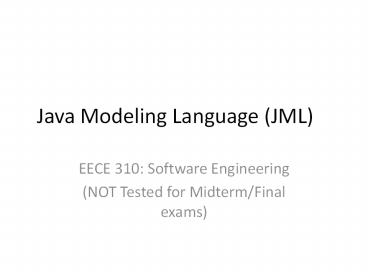Java Modeling Language (JML) - PowerPoint PPT Presentation
Title:
Java Modeling Language (JML)
Description:
Java Modeling Language (JML) EECE 310: Software Engineering (NOT Tested for Midterm/Final exams) Learning Objectives Identify uses and syntax of JML Write ... – PowerPoint PPT presentation
Number of Views:516
Avg rating:3.0/5.0
Title: Java Modeling Language (JML)
1
Java Modeling Language (JML)
- EECE 310 Software Engineering
- (NOT Tested for Midterm/Final exams)
2
Learning Objectives
- Identify uses and syntax of JML
- Write specifications of simple methods in JML
3
Java Modeling Language (JML)
- JML is a behavioral interface specification
language - JML is a specification language that allows
specification of the behavior of an API - not just its syntax, but its semantics
- JML specifications are written as annotations
- As far as Java compiler is concerned they are
comments but a JML compiler can interpret them
4
JML
- Goal Make writing specifications easily
understandable and usable by Java programmers, - so it stays close to the Java syntax and
semantics - JML supports design by contract style
specifications with - Pre-conditions
- Post-conditions
- (Class) invariants
5
JMLAnnotations
- JML annotations are added as comments to the Java
source code - either between /_at_ . . . _at_/
- or after //_at_
- These are annotations and they are ignored by the
Java compiler - JML properties are specified as Java boolean
expressions - JML provides operators to support design by
contract style specifications such as \old and
\result - JML also provides quantification operators
(\forall, \exists) - JML also has additional keywords such as
- requires, ensures, signals, assignable, pure,
invariant, non null, . . .
6
JML contracts
- Preconditions (REQUIRES) are written as a
requires clauses - Postconditions(EFFECTS) are written as ensures
clauses - MODIFIES are written as modifiable clauses
- Rep invariants are written as invariants clauses
7
Simple Example
- Consider the spec. of a swap routine in Java
- public static void swap(int a)
- / _at_ requires a.length 2
- _at_ modifiable a
- _at_ ensures ( (a0\old(a1)
- _at_ (a1\old(a0)
) - /
8
Simple Example Exception
- Consider the spec. of a swap routine in Java
- But assume that it throws an exception when
given an array of length ! 2. - public static void swap(int a)
- / _at_ modifiable a
- _at_ ensures ( (a0\old(a1)
- _at_ (a1\old(a0)
) - _at_ signals NullPtrException (a NULL)
- _at_ signals LengthException (a.length !
2) - /
9
JML Quantifiers
- JML supports several forms of quantifiers
- Universal and existential (\forall and \exists)
- General quantifiers (\sum, \product, \min, \max)
- Numeric quantifier (\num_of)
- (\forall Student s class272.contains(s)
s.getProject() ! null) - (\forall Student s class272.contains(s) gt
s.getProject() ! null) - Without quantifiers, we would need to write loops
to specify these types of constraints
10
JML Quantifiers (cont)
- Quantifier expressions
- Start with a declaration that is local to the
quantifier expression - (\forall Student s ...
- Followed by an optional range predicate
- ... class272.contains(s) ...
- Followed by the body of the quantifier
- ... s.getProject() ! null)
11
JML quantifiers (cont)
- \sum, \product, \min, \max return the sum,
product, min and max of the values of their body
expression when the quantified variables satisfy
the given range expression - For example,
- (\sum int x 1 lt x x lt 5 x) denotes the sum
of values between 1 and 5 inclusive - The numerical quantifier, \num_of, returns the
number of values for quantified variables for
which the range and the body predicate are true
12
Group Activity
- Write the specification in JML for the search
routine you identified earlier (See below) - public static int search(int a, int x) throws
NullPointerException, ElementNotFound - // EFFECTS if a is NULL, throw NPException.
- // else if x is not found in a, throw
ENFException - // else return the index of element x in the
array - // i.e., return i such that aix, 0 lti lt
a.length
13
JML Libraries
- JML has an extensive library that supports
concepts such as sets, sequences, and relations. - These can be used in JML assertions directly
without needing to re-specify these mathematical
concepts
14
JML Tools
- tools for parsing and typechecking Java programs
and their JML annotations - JML compiler (jmlc)
- tools for supporting documentation with JML
- HTML generator (jmldoc)
- tools for runtime assertion checking
- Test for violations of assertions (pre,
postconditions, invariants) during execution - Tool jmlrac
- testing tools based on JML
- JML/JUnit unit test tool jmlunit
- Extended static checking
- Automatically prove that contracts are never
violated at any execution - Automatic verification is done statically (i.e.,
at compile time). - Tool ESC/Java
15
Summary
- JML is a formal mathematical languages for
writing specifications in Java - Can use most Java features such as objects,
fields - Loops and side-effects not allowed however
- Use quantifiers (\forall, \exists) in place of
loops - You will NOT need to use JML for the exams. But,
you will need it for the assignments.































